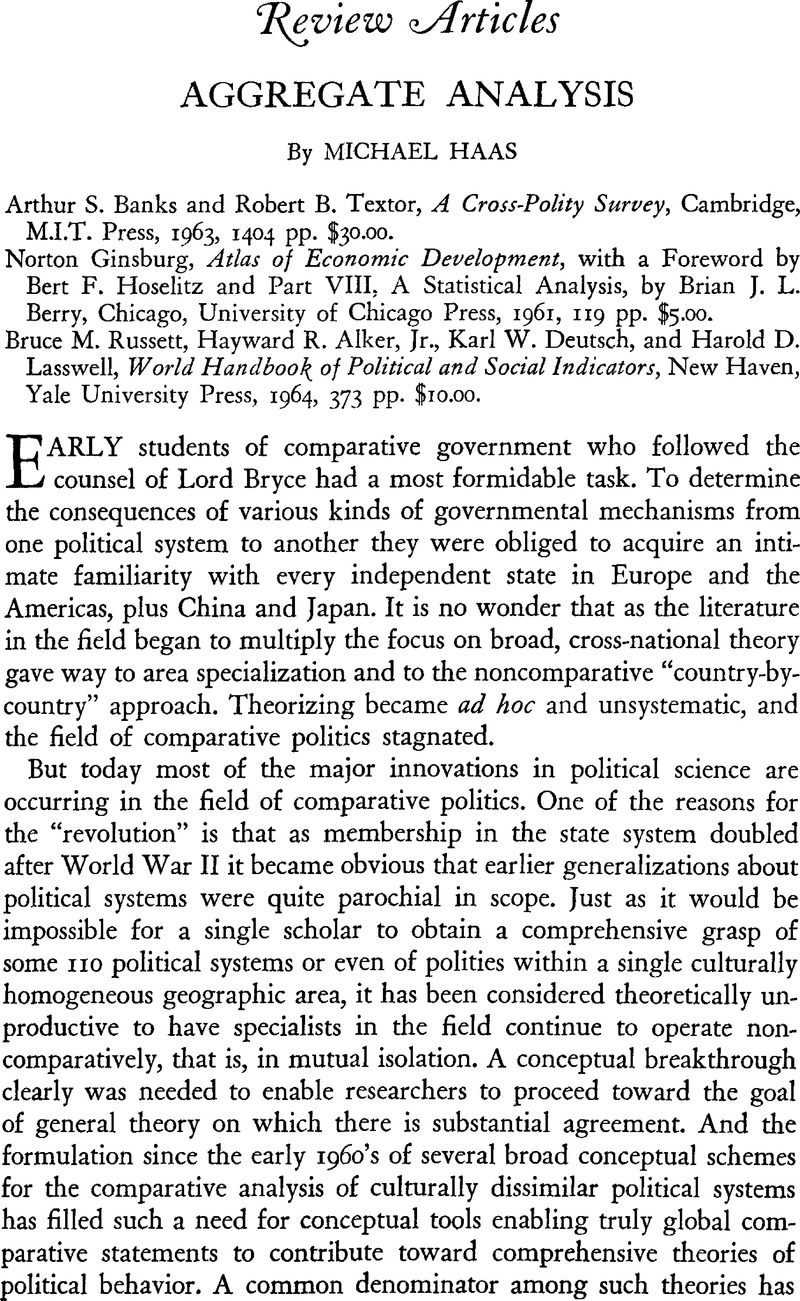Article contents
Abstract

- Type
- Review Article
- Information
- Copyright
- Copyright © Trustees of Princeton University 1966
References
1 See Banks, 45-47. Very often, however, there is such a large pileup of cases in one of the initial attribute subdivisions that statistical significance cannot be attained with contingency correlation coefficients.
2 Nixon, Raymond B., ”Factors Related to Press Freedom,” Journalism Quarterly, XXXVII (Winter 1960), 13–28Google Scholar; , Nixon, ”Freedom in the World's Press: A Fresh Appraisal with New Data,” Journalism Quarterly, XLII (Winter 1965), 3–14.Google Scholar
3 ”Dimensions of Conflict Behavior Within and Between Nations,” General Systems, vi (1963), 1–50Google Scholar
4 U.S. Department of State, Bureau of Intelligence and Research, World Strength of Communist Party Organizations.
5 See Murdock, George Peter, Social Structure (New York 1949Google Scholar). In contradistinction to my use of the term ”political anthropology,” Easton uses it to refer to the study by anthropologists of political arrangements and processes among preliterate peoples; see Easton, David, ”Political Anthropology,” Biennial Review of Anthropology, 1 (1959). 210Google Scholar–62.
6 Gregg, Phillip M. and Banks, Arthur S., ”Dimensions of Political Systems: Factor Analysis of A Cross-Polity Survey,” American Political Science Review, LIX (September 1965), 602CrossRefGoogle Scholar–14; , Banks and , Gregg, ”Grouping Political Systems: Q-Factor Analysis of A Cross-Polity Survey,” American Behavioral Scientist, ix (November 1965), 3–6Google Scholar; Banks, ”A Cross-Polity Survey: Preliminary Analysis,” paper presented at the annual meeting of the American Political Science Association, Chicago, September 1964; Russett, Bruce M., ”Delineating International Regions,” in Singer, J. David, ed., Quantitative International Politics (New York 1966)Google Scholar; Merritt, Richard and Rokkan, Stein, eds., Comparing Nations (New Haven 1966).Google Scholar
7 For a fuller discussion of the many purposes that factor analysis may serve, see Rummel, Rudolph J., Applied Factor Analysis (EvanstonGoogle Scholar, forthcoming), chap. 2.
8 Deutsch, Karl W. and Eckstein, Alexander, ”National Industrialization and the Declining Share of the International Economic Sector, 1890–1959,”; World Politics, xm (January 1961), 267CrossRefGoogle Scholar–99; Haas, Michael, ”Social Change and National Aggressiveness,” in Singer, Quantitative International Politics.Google Scholar
9 Atlas, 116–17; Pye, Lucian W., Politics, Personality, and Nation Building (New Haven 1962), chap. 2.Google Scholar
10 Modelski, George, ”Comparative International Systems,” World Politics, xiv (July 1962), 662CrossRefGoogle Scholar–74; Kaplan, Morton A., System and Process in International Politics (New York 1957Google Scholar); Haas, Michael, ”A Functional Approach to International Organization,” Journal of Politics, xxvn (August 1965), 498–517Google Scholar; Rosecrance, Richard N., Action and Reaction in World Politics (Boston 1963Google Scholar).
11 The Achieving Society (Princeton 1961Google Scholar). For a discussion of current problems in content analysis, see Sola Pool, Ithiel de, ed., Trends in Content Analysis (Urbana 1959Google Scholar).
12 Scott, Andrew M., with Lucas, William A. and Lucas, Trudi M., Simulation and National Development (New York 1966Google Scholar).
- 2
- Cited by




